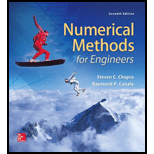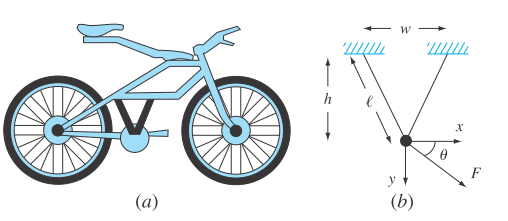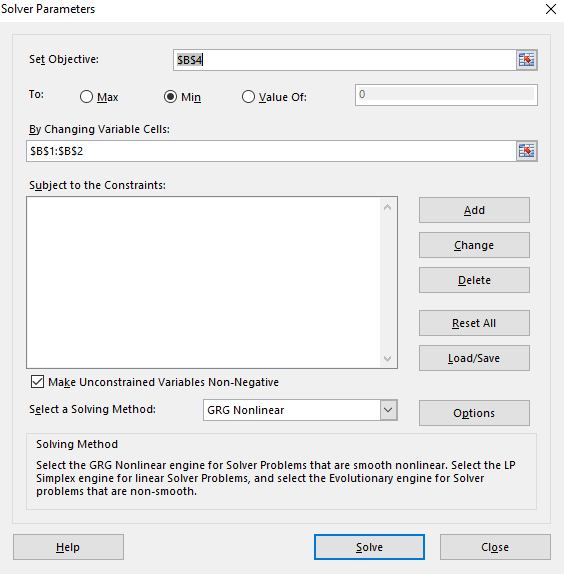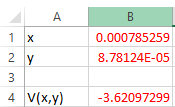
Recent interest in competitive and recreational cycling has meant that engineers have directed their skills toward the designand testing of mountain bikes (Fig. P16.33a). Suppose that you are given the task of predicting the horizontal and vertical displacement of a bike bracketing system in response to a force. Assume the forces you must analyze can be simplified as depicted in Fig. P16.33b. You are interested in testing the response of the truss to a force exerted in any number of directions designated by the angle

FIGURE P16.33
(a) A mountain bike along with (b) a free-body diagram for a part of the frame.
To calculate: The minimum potential energy with displacement

Answer to Problem 33P
Solution:
The minimum potential energy with displacement
Explanation of Solution
Given Information:
The parameters are given as Young’s modulus E is

Calculation:
Consider the free body diagram,

The potential energy at a position where horizontal displacement is x and vertical displacement is y, first consider the angular deflection of the bracket and then use the concept of energy stored in a bracket system due to deflection.
For
Substitute the values
To minimize this, the excel solver can be used to solve for the displacement.
The excel solver steps are,
Step 1. Initiate quantity

Step 2. Apply the formula in

Step 3. Go to DATA and then click on Solver. This dialog box will appear.

Step 4. Select the set objective, min, changing variable then this dialog box appears.

Step 5. Click on Solve and then OK.

Hence, the minimum potential energy with displacement
Put
The potential energy can be found out with upper procedure as
The potential energy will be
Thus from the above analysis, it can be concluded that x deflection is maximum when load is pointed in the x direction and y deflection is maximum when load is pointed in the y direction.
However x deflection is more than y direction as potential energy is higher at lower angle.
This can also be concluded that if w values increases then deflection would be more uniform throughout.
Want to see more full solutions like this?
Chapter 16 Solutions
Numerical Methods for Engineers
- A crate of 69 kg simply stands on the moving cart with constant acceleration a. The height from the center of gravity to the cart, L, is 1.4 m, and the angle = 13°. What is the maximum acceleration a (in m/s²) the cart can have without sliding on the cart? The coefficient of static friction between the crate and the cart is μl g = 0.51. Please pay attention: the numbers may change since they are randomized. Your answer must include 3 places after the decimal point. Take g = 9.81 m/s². 0.5 m 0.5 m L Your Answer: Answer Garrow_forwardA webassign.net O eBook 12. DETAILS OSUNIPHYS1 6.P.124. MY NOTES ASK YOUR TEACHER As shown below, the coefficient of kinetic friction between the surface and the larger block is 0.20, and the coefficient of kinetic friction between the surface and the smaller block is 0.30. If F = 75 N and M = 4.0 kg, what is the tension (in N) in the connecting string? 2M M Additional Materials eBook 13. DETAILS PREVIOUS ANSWERS OSUNIPHYS1 6.P.126. MY NOTES ASK YOUR TEACHE Two blocks are stacked as shown below, and rest on a frictionless surface. There is friction between the two blocks (coefficient of friction u). An external force is applied to the top block at an angle 0 with the horizontal. What is the maximum force F that can be applied for the two blocks to move together? (Enter thearrow_forwardPlease answer and show how you got it You are on an elevator fixed to a wall that can move up and down freely while you pull with a force of 150 N on a massless rope (the orange line in the diagram below) with length L. This rope is connected to one end of a beam with the same length, L, and mass m=20 kg. The left end of the beam is in contact with the same wall the elevator is on and the coefficient of static friction =0.2 between the beam and the wall. See diagram below for a representation of the situation and note that free fall acceleration points directly downward 0 L Part A) Label all the forces acting on the beam and discuss the direction of any torques exerted on the beam about the contact point between the beam and the wall Part B) What is the maximum angle the beam can subtend with respect to the horizontal _m such that it will just begin to slip? Potentially useful trig identities are sin(2x)=2sin(x)cos, sin(180-x)=sin(x), sin(90+x)=cos(x)arrow_forward
- Drop-load (I)This exercise is part of a series of problems aimed at modelling a situation by progressively refining our model to consider more and more parameters. This progressive approach is very close to what professional scientists do! Context We want to lower a suspended load in a controlled way so that it hits the ground with a speed whose modulus is not too great. To do this, the suspended load (B) is connected by a rope passing through a pulley to another mass (A), which can move on a horizontal surface. Information The masses of the charges A and B are known.The pulley is a ring of mass mp and radius R that can rotate without friction.The surface on which mass A is placed is horizontal.There is no friction between mass A and the surface on which it is placed.The string attached to mass A is perfectly parallel to the surface on which the mass rests. SchematizationDraw a diagram of each object that interests us. Draw x- and y-axes for each object. Draw and name each force…arrow_forwardA physics lab Consist of a large bowl attached to wire. Students hold onto one of the wire the whirl the ball around in circles and count the number of rotations per second. One group finds these numbers: ball mass=320g, wire length=1.3m, number of rotations/second=2.5. The wire is made of steel with a diameter of 1mm and a Young’s modulus of 20x10^10 N/m^2. How much does the wire stretch due to the tension on it? Should the students correct their data for the wire stretching?arrow_forwardYou have been selected as a potential intern in a construction company in Aqaba, Jordan. For evaluation purposes, you were asked to answer the following question. Two wooden boxes are moving on an inclined surface as shown in Figure 2. Wooden Box A Non- Frictional Surface Non- Frictional Surface 60 Figure 2: Wooden Baxes Answer the following questions using the D'Alembert's principle. Note that the mass of box A is M1 and the mass of box B is M2. Wooden Boxarrow_forward
- Q: Block(A) of weight (100kN) is tied to block (B) of unknown weight (Ws) through a flexible cable passing over a smooth pulley .The coefficient of friction for block (A) is (0.3) and for block (B) is (0.2).Find the range of the weight of block (B) to remain in static equilibrium. Smooth pulleyarrow_forwardStyles Editing Show a trend using graphical solution with added friction mu = 0.25, hanger mass values = 4 kg & 8 kg Incline 40 degrees, incline-object=2 kg, sliding friction coefficient mu=0.25 Use 9.8 m/s/s for g Explain the graph as a justification 45. A 2.00 kg block (mass 1) and a 4.00 kg block (mass 2) are connected by a light string as shown; the inclination of the ramp is 40.0°. Friction is negligible. What is (a) the acceleration of each block and (b) the tension in the string? 2. 40° D Focusarrow_forwardYou pull on a large box using a rope as in Fig. 5.21a, except the rope is at an angle of 15.0° below the horizontal. The weight of the box is 325 N, and the coefficient of kinetic friction between the box and the floor is 0.250. (a) What must be the tension in the rope to make the box move at a constant velocity? (b) What is the normal force that the floor exerts on the box?arrow_forward
- ..A mass of 4kg rests on a horizontal plane. The plane is gradually inclined until at an angle e= 15° with the horizontal, the mass just begins to slide. What is the coefficient of static friction between the block and the surface?arrow_forwardDescribe classification of force. Tell about principle of transmissibility. What are rectangular components of force? Identify the rectangular Q: 1 Q: 2 components of force in two-dimensional system. Q: 3 Differentiate between moment and couple? Describe moment and couple in three-dimensional system. Describe the methodology used to formulate and solve statics problems. Determine the weight in newtons of small aeroplan model whose mass is Q: 4 |Q: 5 1800 kg. Convert the mass of aeroplan model to slugs and then determine its weight in pounds.arrow_forwardYou have been selected as a potential intern in a construction company in Aqaba, Jordan. For evaluation purposes, you were asked to answer the following question. Two wooden boxes are moving on an inclined surface as shown in Figure 2. Wooden Воx A Non- Frictional Surface Non- Frictional Surface Figure 2: Wooden Boxes Answer the following questions using the D'Alembert's principle. Note that the mass of box A is M1 and the mass of box B is M2. 1. Find the tension in the rope, in terms of M1 and M2. 2. Calculate the acceleration of the wooden boxes, in terms of M1 and M2. Wooden Boxarrow_forward
 Elements Of ElectromagneticsMechanical EngineeringISBN:9780190698614Author:Sadiku, Matthew N. O.Publisher:Oxford University Press
Elements Of ElectromagneticsMechanical EngineeringISBN:9780190698614Author:Sadiku, Matthew N. O.Publisher:Oxford University Press Mechanics of Materials (10th Edition)Mechanical EngineeringISBN:9780134319650Author:Russell C. HibbelerPublisher:PEARSON
Mechanics of Materials (10th Edition)Mechanical EngineeringISBN:9780134319650Author:Russell C. HibbelerPublisher:PEARSON Thermodynamics: An Engineering ApproachMechanical EngineeringISBN:9781259822674Author:Yunus A. Cengel Dr., Michael A. BolesPublisher:McGraw-Hill Education
Thermodynamics: An Engineering ApproachMechanical EngineeringISBN:9781259822674Author:Yunus A. Cengel Dr., Michael A. BolesPublisher:McGraw-Hill Education Control Systems EngineeringMechanical EngineeringISBN:9781118170519Author:Norman S. NisePublisher:WILEY
Control Systems EngineeringMechanical EngineeringISBN:9781118170519Author:Norman S. NisePublisher:WILEY Mechanics of Materials (MindTap Course List)Mechanical EngineeringISBN:9781337093347Author:Barry J. Goodno, James M. GerePublisher:Cengage Learning
Mechanics of Materials (MindTap Course List)Mechanical EngineeringISBN:9781337093347Author:Barry J. Goodno, James M. GerePublisher:Cengage Learning Engineering Mechanics: StaticsMechanical EngineeringISBN:9781118807330Author:James L. Meriam, L. G. Kraige, J. N. BoltonPublisher:WILEY
Engineering Mechanics: StaticsMechanical EngineeringISBN:9781118807330Author:James L. Meriam, L. G. Kraige, J. N. BoltonPublisher:WILEY





